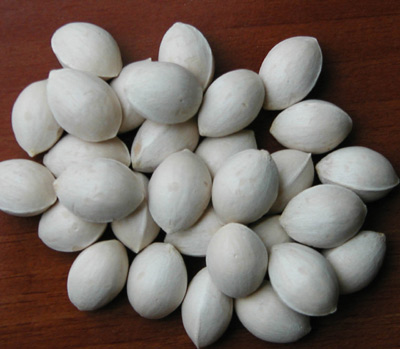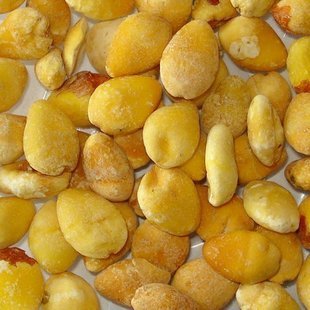白果
The Processing of 白果
Origin
The dry seed of Ginkgo biloba L. of family Ginkgoaceae.
Location
Guangxi, Sichuan and Henan provinces and so on in China.
Harvest
Collected in autumn.
The actual smell and taste
No bad smell, slightly sweet and bitter taste.
Best quality
Large and yellowish white color of shell, plump kernel with light yellow color of cross-section. The best one is in Guangxi province.
Processing
Removed external seed coat, cleaned, slightly steamed or slightly decocted, then oven dried; unprocessed or stir-baked; smashed.
The Effect of 白果
Property
Sweet, bitter, astringent, neutral, slightly toxic; lung and kidney meridians entered.
Actions
Relieve cough and dyspnea, astringe lung and resolve phlegm, stop leukorrhagia, reduce urination.
Indications
A. Phlegmatic dyspnea and cough
This herb has actions of astringing lung to stop dyspnea and cough and resolving dampness to direct phlegm, so it is often indicated for phlegmatic dyspnea and cough. For dyspnea due to wind-cold and phlegm retention, it is often combined with lung-ventilating and dyspnea-relieving herbs. It is often combined with Ma Huang which has the actions of ventilating lung and relieving dyspnea. Bai Guo is astringing and Ma Huang is ventilating. The combination of them can obtain the result of astringing lung without retaining pathogen and ventilating lung without damaging qi. For instance it is often combined with Ma Huang in Ya Zhang San from She Sheng Zhong Miao Fang (Excellent Prescriptions for Keeping Health). For dyspnea and cough with breathlessness and profuse yellow-thick phlegm due to external contraction of wind-cold and internal heat, it is combined with lung-heat-clearing and purging herbs, such as Huang Qin, and Sang Bai Pi and so on in Ding Chuan Tang from She Sheng Zhong Miao Fang. For dryness cough of lung heat and dyspnea with suffocation without phlegm, it is combined with herbs to tonify yin and moisten lung to stop cough. For instance, it is combined with Mai Dong and Kuan Dong Hua and so on. For dyspnea of deficiency type due to deficiency of both the lung and kidney, it is combined with herbs to tonify kidney, improve qi reception and astringe lung to relieve dyspnea. For instance, it is combined with Hu Tao Rou, Shan Yao and Wu Wei Zi, etc.
B. Leukorrhagia, enuresis
This herb can astringe to strengthen the lower energizer, also resolve the dampness and turbid. So it is often indicated for stopping leukorrhagia and reducing urination. For leukorrhagia due to deficiency of the spleen and kidney, it is combined with spleen and kidney-tonifying herbs and leukorrhagia-stopping herbs, such as Shan Yao and Lian Zi and so on. For damp-heat leukorrhagia with yellow color and fish smell, it is combined with heat-clearing and damp-removing and leukorrhagia-stopping herbs. For instance, it is combined with Huang Bai and Che Qian Zi and so on, in Yi Huang Tang from Fu Qing Zhu Nv Ke. For frequent micturition, enuresis and emissions due to insecurity of kidney qi, it is often combined with kidney-tonifying herbs and essence-securing and urination-reducing herbs. For instance, it is combined with Shan Zhu Yu and Fu Pen Zi and so on.
Dosage and Administrations
Decoct 5~10 g. Smash.
Cautions
It is contraindicated for raw use because this unprocessed herb is toxic. Take overdose of stir-baked herb can also induce toxication, especially for infants. Being astringe property, it should be used with cautions for cough and dyspnea with thick phlegm and difficult in spitting out.

